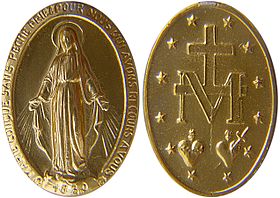Adrien-Jean-Maximilien Vachette (born 9 January 1753 in Cauffry – deceased 23 September 1839 in Paris) was a French goldsmith best known for the production of ornate gold boxes and the use of unusual and natural materials like tortoiseshell.

Biography
editAdrien Vachette was born in Cauffry and possibly apprenticed with Pierre-François Drais, who sponsored him for a master's certificate 21 July 1779.[1] He had a shop at Place Dauphine in Paris, and worked for a time with Marie-Etienne Nitot during the First Empire, and with the firm of Ouizille and Lemoine after the restoration of the monarchy:[2] In 1816, Charles Ouizille and Adrien Vachette became the official jewellers of Louis XVIII's court.[3]
Notable students include Jean-Valentin Morel, who apprenticed with Vachette before opening his own shop in Paris.
Work
editAdrien Vachette was a prolific designer and one of the most noted master craftsman of his generation.[4] The use of unusual and natural materials like tortoise shell was characteristic of Vachette's work.[5]
Vachette created the design for the Miraculous Medal, or the Medal of the Immaculate Conception, after Saint Catherine Labouré's vision of the Blessed Virgin Mary. He produced and sold over two million of the medals between 1832 and 1836.[6]
Collections
edit- The Louvre in Paris: 31 boxes signed by Vachette (16 from Ancien Régime, 15 from post-revolution).
- Victoria and Albert Museum in London: 1 box painted by Jacques-Joseph de Gault
- Waddesdon Manor of the Rothschild Foundation: 4 boxes
- Metropolitan Museum of Art: Cameo of the Virgin and Child and Snuffboxes
- Khalili Collection of Enamels of the World: 1 boîte à mouches[7][8]
Gallery
edit-
Cameo of the Virgin and Child.
-
French, Paris; Snuffbox, painting; Metalwork-Gold and Platinum.
-
French, Paris; Snuffbox; Metalwork-Gold and Platinum.
-
Snuffbox with four maritime scenes; Louis XIV crossing the Rhine in 1672.
-
Les enfants de Lucien Bonaparte, orfèvre Adrien Vachette - Musée du Louvre.
-
Miniature portrait of the Empress Josephine on an 18k gold snuff box, with Jean Baptiste Isabey. Circa 1810.
-
Micromosaic made in Rome, gold box made in Paris, Micromosaic 1804, box 1809–1819, with Clemente Ciuli.
References
edit- ^ Habsburg, Géza von (1983). Gold boxes: from the collection of Rosalinde and Arthur Gilbert.
- ^ "Antique French rectangular agate and gold box by Adrien-Jean-Maximilien Vachette, Paris 1798-1809". Sjphillips.com. Retrieved 26 December 2018.
- ^ "Tabatière ovale en or montée à cage ornée de miniatures du port de Brest et de paysages maritimes". Galeriekrugel.com (in French). Retrieved 26 December 2018.
- ^ International art market and Art & auctions, Volumes 11-14. Interart Publishers. 1971.
- ^ "Snuffbox". Retrieved 27 February 2012.
- ^ Mack, John (2003). The museum of the mind: art and memory in world cultures. British Museum.
- ^ "Boîte à Mouches". Khalili Collections. Archived from the original on 2020-10-22. Retrieved 2020-12-04.
- ^ Williams, Haydn, ed. (2009). Enamels of the world, 1700-2000 : the Khalili collections. Khalili Family Trust. p. 238. ISBN 978-1-874780-17-5.